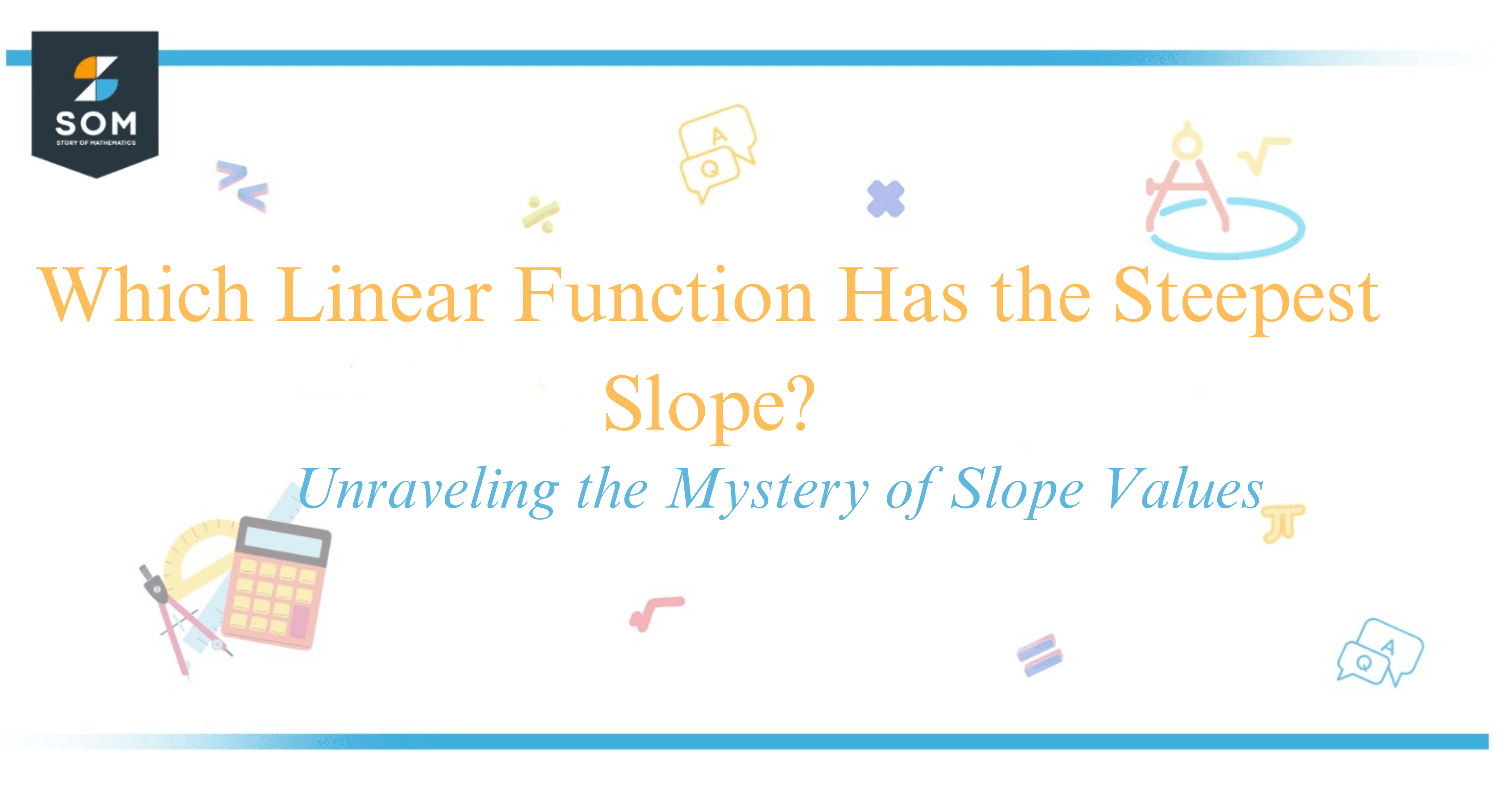JUMP TO TOPIC

The steepest slope of a linear function represents the greatest rate of change on its graph. In mathematical terms, slope is the measure of steepness or the angle of incline and is usually denoted by the letter ‘m’.
When evaluating the steepness of linear functions, I look at the magnitude of the slope—the larger the number, whether positive or negative, the steeper the line.
For example, a linear function with a slope of $m = 5$ is steeper than one with a slope of $m = 2$. Likewise, when comparing $m = -5$ and $m = -2$, the former is steeper due to its larger absolute value.

To visualize this concept, I consider how each linear function is plotted on a graph. The slope indicates how much the line goes up or down for each unit of horizontal movement to the right.
For steep lines approaching vertical, the value of the slope tends toward infinity, while for flatter lines approaching horizontal, the slope approaches zero.
My intrigue in this concept grows when I think about real-world applications such as calculating gradients in physical landscapes or understanding economic trends.
Function with Steepest Slope
When discussing the steepness of a linear function, we refer to the slope as the primary measure.

I understand that slope is calculated as the ratio of rise to run ($\text{rise over run}$), which is the change in y ($\Delta y$) over the change in x ($\Delta x$), using the slope formula $\frac{\Delta y}{\Delta x}$. The slope indicates how fast the vertical change happens about the horizontal change.
| Notation | Meaning |
|---|---|
| $\Delta y$ | Change in y (Vertical change) |
| $\Delta x$ | Change in x (Horizontal change) |
For the steepest linear function, we are considering almost vertical lines. The closer to vertical a line is, the greater the absolute value of its slope will be.
When we talk about steepness, both positive and negative slopes can be considered; it’s the absolute value that matters for steepness.
- A positive slope means the line inclines upward as we move from left to right.
- A negative slope means the line declines downward as we move from left to right.
Now, horizontal lines have slope of 0, as there is no vertical change ($\Delta y=0$), regardless of the horizontal change ($\Delta x$).
Conversely, vertical lines have an undefined slope, because the horizontal change ($\Delta x$) is 0, making the denominator in our slope calculation zero.
Functions that are parallel share the same slope, and perpendicular lines have slopes that are negative reciprocals of one another. The steepest slope then, in theory, approaches infinity ($\pm\infty$) as the line becomes vertical.
For further exploration on how to calculate and understand slopes, I recommend watching a video lesson on slope and rate of change to see visual examples of these concepts in action.
Characteristics of Functions With Steepest Slopes
When I’m analyzing the behavior of linear functions, their slopes tell me a lot about their steepness and direction. A linear function with a positive slope means the line slants upward as it moves from left to right.
Conversely, a line with a negative slope goes downward. The steeper the line, the larger the absolute value of its slope.
Interestingly, slopes can be conveyed through a simple but powerful equation: $ m = \frac{y_2 – y_1}{x_2 – x_1} $ This is the slope formula, where ( m ) stands for slope, and $ (x_1, y_1)$, $(x_2, y_2) $ are two distinct points on the line. A slope of zero indicates a horizontal line (zero slope)—it doesn’t rise or fall.
Conversely, an undefined slope corresponds to a vertical line, which can’t be represented by a standard slope value because dividing by zero is undefined. Hence, in terms of steepness, vertical lines could be considered to have an infinitely steep slope.
Here’s a snapshot using a table for clear comparison:
| Slope (m) | Slope Type | Line Direction | Equation Example |
|---|---|---|---|
| ( m > 0 ) | Positive | Upward from left to right | ( y = mx + b ) |
| ( m < 0 ) | Negative | Downward from left to right | ( y = -mx + b ) |
| ( m = 0 ) | Zero | Horizontal line | ( y = b ) |
| Undefined | Infinite/Vertical | Vertical line | ( x = a ) |
To identify which linear function has the steepest slope, we would look at the line closest to vertical amongst those being compared, effectively an extreme of an undefined slope.
Graphical Representation of Slope
When I look at a graph, the slope of the line is something that immediately catches my eye. It tells me how steep a line is.
In mathematical terms, the slope is the ratio of the vertical change (y-values) to the horizontal change (x-values) between two points on a line. To put it into an equation, the slope m is defined as $m = \frac{\Delta y}{\Delta x} $.
Let’s consider plotting a line with two points on a graph. Suppose the coordinates of these points are $ (x_1, y_1) $ and $(x_2, y_2) $. The change in y (Δy) is $y_2 – y_1 $, and the change in x (Δx) is $x_2 – x_1 $. So, if I wanted to calculate the slope, my formula would now look like $m = \frac{y_2 – y_1}{x_2 – x_1} $.
A common form of a linear equation is the slope-intercept form, which is ( y = mx + b ), where m is the slope and b is the y-intercept. The y-intercept is where the line crosses the y-axis.
Here’s a simple illustration of two graph lines:
| Line | Slope | Y-Intercept |
|---|---|---|
| Red line | ( m_1 ) | ( b_1 ) |
| Blue line | ( m_2 ) | ( b_2 ) |
The steepness of the line is visually apparent when I look at a graph. For example, if the blue line has a slope of ( m = 3 ), it rises three times as fast as it moves horizontally, which means it’s relatively steep.
In contrast, a line with a slope of 1/3 would rise much more gradually, indicating a gentle slope.
Understanding the slope on a graph helps me to determine the relationship between variables and predict the steepness of real-world scenarios, such as hills or rates of change.
Conclusion
In my exploration of linear functions and their slopes, I’ve uncovered that the steepest slope corresponds to an almost vertical line.
A linear function with an increased steepness will have a larger absolute value of its slope, represented mathematically as ( |slope| ). The slope can be positive or negative, where a positive slope indicates an upward tilt and a negative slope indicates a downward tilt as we move from left to right on a graph.
To identify the steepest slope, I look at the absolute value of the slope, since this tells us about the steepness irrespective of the direction of the line.
For instance, a line with a slope of $-\frac{4}{3}$ is steeper than a line with a slope of $ \frac{3}{5} $, as $|-\frac{4}{3}| > |\frac{3}{5}| $.
The steepest slope will be the one that approaches being vertical, which mathematically would mean the slope is tending towards infinity $( \infty )$or negative infinity $( -\infty )$.
To conclude, when I need to determine which linear function has the steepest rise or fall, I scrutinize the absolute values of their slopes.
The largest of these will point me to the function with the steepest incline, giving me clear insight into the behavior of linear relationships in various contexts, from physical slopes to the rate of change in a given scenario.
